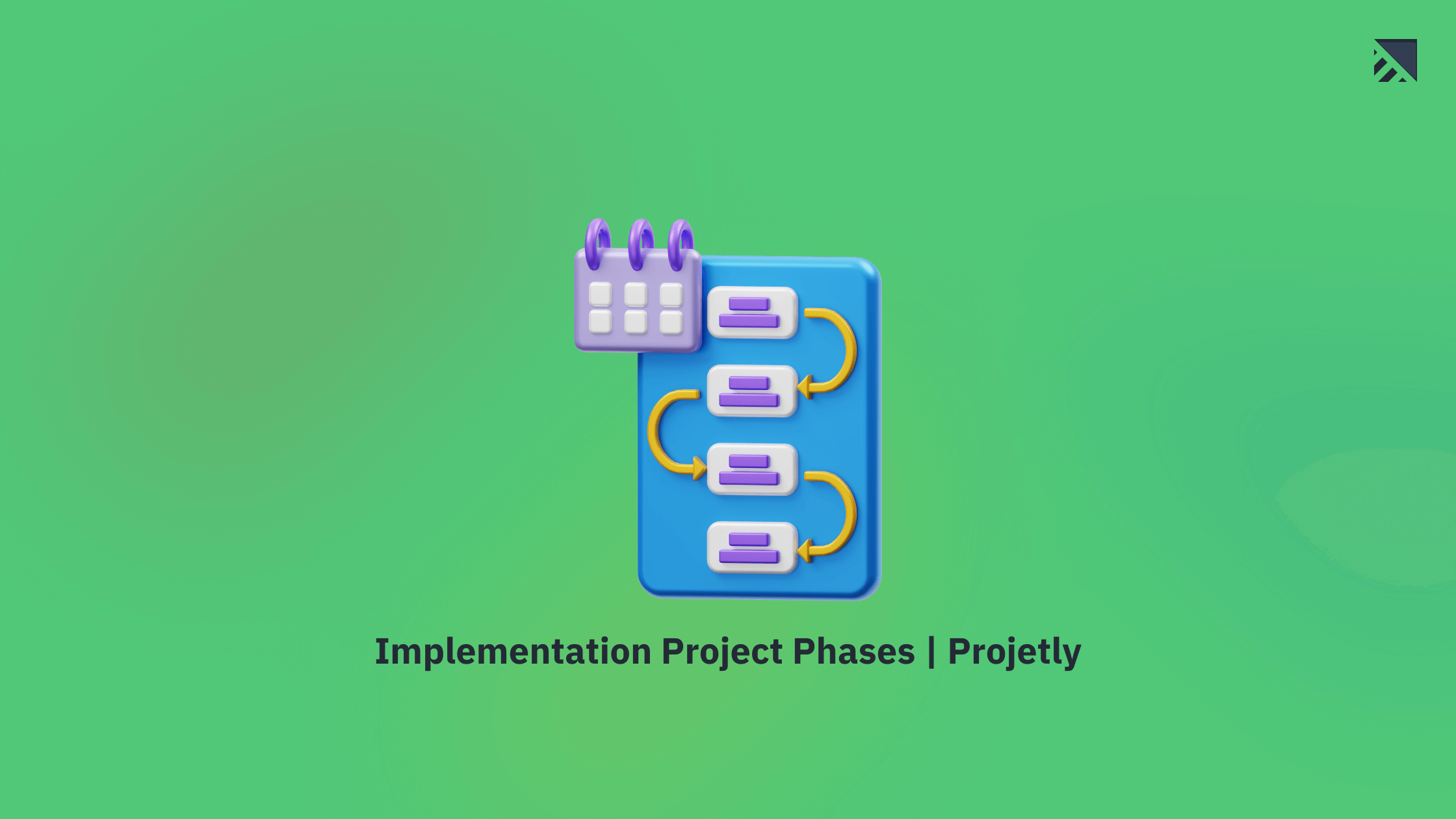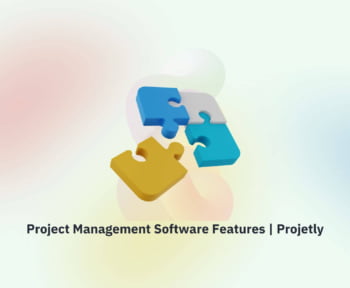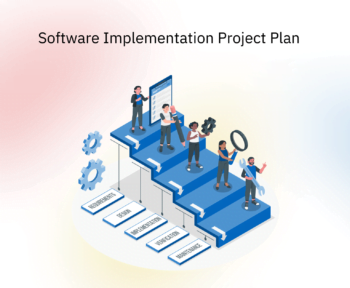Introduction
In today’s business environment, implementing a software solution for a new client is a complex task. It requires careful planning, seamless collaboration, and a commitment to delivering an exceptional customer experience. This guide will provide you with the knowledge and strategies you need to navigate the software implementation process with ease. Without easting much time, let’s dive into the topic.
Table of Contents
Implementation Project Phases Roadmap
Phase 1: Laying the Groundwork – Meticulous Planning and Preparation
Embarking on an implementation project demands a solid foundation built on careful planning and preparation. This initial phase sets the stage for success, ensuring that every subsequent step is executed precisely and aligned with your client’s unique needs.

- Understanding Your Client’s Objectives and Expectations
Before you can chart the course, you must first comprehend the destination. Engage in in-depth discussions with your client to unravel their pain points, aspirations, and desired outcomes. By truly grasping their goals, you can tailor your solutions accordingly, prioritizing features that deliver maximum value and setting realistic timelines that align with their expectations.
- Assessing the Client’s Infrastructure and Readiness
Conducting a comprehensive assessment of your client’s existing infrastructure is crucial. Evaluate their hardware, software, network capabilities, and business processes to identify potential compatibility issues or gaps that may require customization or additional training. This proactive approach allows you to mitigate risks and ensure a seamless integration of your software solution.
- Crafting a Detailed Implementation Plan
With a firm grasp of your client’s requirements and operational landscape, it’s time to craft a meticulously detailed implementation plan. Outline clear timelines, milestones, and responsibilities, leaving no stone unturned. Communicate regularly with your clients, fostering transparency and keeping them engaged. Anticipate potential challenges and develop contingency strategies to mitigate risks proactively.
Related blog: How to Create a Project Implementation Plan Format that Works
Phase 2: Fostering Collaboration and Communication
Effective communication and collaboration are the cornerstones of a successful implementation project phases. This phase emphasizes building solid relationships with key stakeholders and establishing clear lines of communication, ensuring everyone remains aligned and informed throughout the journey.

- Identifying and Engaging Key Stakeholders
Pinpoint the individuals who will play pivotal roles in the implementation process, including senior management, department heads, end-users, and IT personnel. Involve them from the outset, fostering a collaborative environment where their requirements and expectations are heard and actively incorporated into the decision-making process.
- Establishing Transparent Communication Channels
Implement a robust communication strategy that keeps all stakeholders informed and engaged. To facilitate seamless information exchange, leverage various tools and platforms, such as email, instant messaging, and project management software. Encourage open and transparent dialogue, allowing your client to provide feedback and voice concerns, further strengthening the trust and partnership.
Did you know? 54% of project management professionals say they lack effective collaboration technology
- Nurturing Collaborative Relationships
A strong relationship with key stakeholders is the foundation for a successful implementation. Foster an environment of mutual respect and understanding by actively involving stakeholders in decision-making and valuing their input. Regular meetings and open communication channels will ensure everyone remains aligned and invested in the project’s success.
Phase 3: Tailoring Solutions and Seamless Integration
In this phase, you’ll harness the power of customization and configuration to mold your software solution to your client’s unique requirements, ensuring a seamless integration with their existing systems and processes.

- Customizing for Optimal Fit
Customization is the key to unlocking your software’s full potential. Modify the user interface, functionality, and workflow to meet your client’s needs. This may involve adding custom fields, creating new reports, or integrating with other systems, ensuring your solution extends its operational ecosystem.
- Configuring System Settings and Parameters
Configuration is fine-tuning your software to align with your client’s preferences and established practices. Define user roles, permissions, and workflows, and configure system parameters to create an environment that promotes a smooth user experience and adherence to their established protocols.
- Integrating with Existing Systems
Seamless integration is the key to fostering a harmonious coexistence between your software and your client’s current infrastructure. Conduct a thorough analysis to identify integration requirements, establish clear plans for connecting systems, configure necessary APIs or data syncing protocols, and rigorously test the integration to ensure data accuracy and functionality.
Phase 4: Data Migration and Rigorous Testing
Data is the lifeblood of any organization, and its migration and validation are critical components of the implementation process. This phase ensures the accurate transfer and integrity of your client’s data, laying the foundation for a smooth transition to your software solution.

- Analyzing and Mapping Data Structures
Before embarking on the migration journey, you must analyze your client’s existing data structures and map them to the new system. This process involves identifying field relationships, data types, and any necessary transformations to ensure compatibility and accuracy.
- Executing Meticulous Data Migration
You can initiate the migration process with a clear understanding of the data landscape. Extract data from the legacy system, transform it to fit the new software’s format, and meticulously clean and verify it to eliminate potential issues or inconsistencies.
- Comprehensive Testing and Validation
Once the data migration is complete, it’s time to put your solution through its paces. Conduct thorough testing, including data integrity tests, boundary tests, and system integration tests, to validate the accuracy and functionality of the migrated data within your software. This rigorous validation process ensures a smooth transition for your client and minimizes potential disruptions.
Phase 5: Empowering Your Client with Knowledge and Support
A successful implementation is not solely about deploying a software solution; it’s about empowering your client to maximize its potential. This phase focuses on providing comprehensive training and unwavering support, ensuring that your client can leverage the full capabilities of your software from day one.

- Conducting Comprehensive Training Sessions
Offer in-depth training sessions, either on-site or remotely, to familiarize your client with the software’s features and functionalities. Tailor the training to their needs and learning styles, ensuring every user feels confident and equipped to navigate the solution seamlessly.
- Developing Comprehensive Training Materials
Supplement your training sessions with well-structured materials, including user guides, video tutorials, and interactive resources. These assets will serve as valuable references, enabling your client to reinforce their learning and troubleshoot any issues arising during their software journey.
- Establishing a Dedicated Support System
A robust support system is crucial for addressing any technical challenges or inquiries your client may encounter. Provide multiple support channels, such as dedicated helplines, email support, and online knowledge bases, to ensure that your client receives prompt assistance and guidance whenever needed.
Phase 6: Continuous Improvement and Optimization
The implementation process continues after your software solution is successfully deployed. This phase emphasizes the importance of ongoing evaluation, optimization, and continuous improvement, ensuring that your client’s experience remains exceptional and that your solution evolves to meet their ever-changing needs.

- Conducting Post-Implementation Evaluations
Seek feedback from your client and analyze performance metrics to assess the effectiveness of your implementation. Identify areas for improvement, address any issues that may have arisen, and gather insights to refine your processes for future deployments.
- Implementing Continuous Optimization
Leverage the insights gained from your post-implementation evaluation to optimize your software’s performance and user experience. Implement regular updates, bug fixes, and enhancements to address identified issues and ensure your solution aligns with your client’s evolving requirements.
- Fostering Ongoing Collaboration
Maintain an open dialogue with your client, encouraging them to share their experiences, challenges, and suggestions for improvement. This collaborative approach strengthens your relationship and provides invaluable insights to inform future iterations and enhancements of your software solution.
Phase 7: Navigating Challenges and Mitigating Risks
While every implementation project is unique, common challenges and risks can arise. Recognizing and proactively addressing these potential roadblocks is crucial for ensuring a smooth and successful implementation.

- Compatibility and Integration Complexities
Integrating your software solution with your client’s existing systems and infrastructure can present challenges. Compatibility issues, data formatting discrepancies, and legacy system constraints can hinder seamless integration. Conduct thorough compatibility assessments and develop contingency plans to mitigate these risks effectively.
- Managing the Learning Curve
Introducing a new software solution often involves a learning curve for your client’s employees. Inadequate training or resistance to change can impede adoption and hamper productivity. Tailor your training approach to different learning styles, provide ongoing support, and foster a culture of continuous learning to overcome this challenge.
- Data Security and Privacy Concerns
Data migration and integration inevitably raise concerns about data security and privacy. To build trust and alleviate your client’s concerns, implement robust security protocols, adhere to industry standards and regulations, and ensure transparency in your data handling practices.
- Scope Creep and Expectation Management
Scope creep, the gradual expansion of project requirements beyond the initial scope, can derail timelines and budgets. Effective communication, clear scope definition, and proactive expectation management are essential to mitigate this risk and ensure your implementation project stays on track.
Phase 8: Leveraging Automation and Streamlining Processes
In today’s digital age, embracing automation and leveraging cutting-edge tools can streamline your implementation processes, enhance efficiency, and deliver a superior customer experience.

- Automating Repetitive Tasks and Workflows
Identify repetitive tasks and workflows within your implementation process and explore opportunities for automation. Leveraging robotic process automation (RPA) or low-code/no-code platforms can significantly reduce manual effort, minimize errors, and accelerate project timelines.
- Integrating Project Management and Collaboration Tools
Implementing robust project management and collaboration tools can revolutionize your implementation processes. These platforms enable seamless task assignment, progress tracking, document sharing, and real-time communication, fostering transparency and ensuring everyone remains aligned and informed throughout the project lifecycle.
- Leveraging Data Analytics and Insights
Harness the power of data analytics to gain valuable insights into your implementation processes. Analyze project metrics, identify bottlenecks, and uncover areas for optimization. These data-driven insights can inform strategic decisions, drive continuous improvement, and ultimately enhance your implementation efforts’ overall efficiency and effectiveness.
Phase 9: Building Long-Term Partnerships and Trust
A successful implementation project is not just a one-time endeavor; it’s the foundation for a lasting partnership built on trust and mutual understanding. This phase emphasizes the importance of nurturing long-term relationships with your clients, ensuring their continued success and satisfaction.

- Establishing a Feedback Loop
Implement a robust feedback loop that encourages open and honest communication with your clients. Actively seek their input, address their concerns, and incorporate their suggestions into your continuous improvement efforts. This collaborative approach fosters trust and demonstrates your commitment to their long-term success.
- Providing Ongoing Support and Guidance
Your role continues after the successful implementation of your software solution. Offer ongoing support and guidance to your clients, ensuring they can leverage your solution’s full potential as their business evolves and new challenges arise. This commitment to their success solidifies your position as a trusted partner.
- Fostering a Culture of Continuous Learning
Embrace a culture of continuous learning within your organization, staying abreast of industry trends, emerging technologies, and best practices. This proactive approach ensures you can anticipate and address your client’s evolving needs, providing them with innovative solutions that keep them ahead.
Phase 10: Celebrating Success and Reflecting on Lessons Learned
As you reach the final phase of the implementation project lifecycle, it’s essential to celebrate your achievements and reflect on the lessons learned along the way.

- Acknowledging Milestones and Achievements
Recognize and celebrate the hard work and dedication of your team and your client’s stakeholders. Highlight the milestones achieved, the challenges overcome, and the successes attained. This acknowledgment fosters a sense of accomplishment and reinforces the value of collaboration and perseverance.
- Conducting Retrospective Sessions
Facilitate retrospective sessions with your team and your client’s stakeholders. Reflect on the implementation process, identify areas for improvement, and capture valuable insights that can inform and refine your future implementation strategies. These sessions promote continuous learning and ensure your organization remains agile and adaptable.
- Documenting Lessons Learned
Meticulously document the lessons learned throughout the implementation project lifecycle. Capture best practices, pitfalls to avoid, and innovative solutions that emerged during the process. This knowledge repository becomes valuable, empowering your team and future clients with a wealth of experience and proven strategies for successful implementations.
Phase 11: Embracing Agility and Adaptability
In today’s rapidly evolving business landscape, agility and adaptability are essential for navigating the ever-changing demands of the market and your clients’ changing needs. This phase emphasizes the importance of fostering a culture of continuous improvement and embracing an agile mindset within your organization.

- Adopting Agile Methodologies
Explore the integration of agile methodologies into your implementation processes. Approaches such as Scrum, Kanban, or Lean principles can enhance collaboration, facilitate rapid adaptation to change, and promote a customer-centric focus throughout the implementation lifecycle.
- Encouraging Innovation and Experimentation
Cultivate an environment that encourages innovation and experimentation within your organization. Empower your team to explore new ideas, technologies, and approaches that can enhance your clients’ implementation experience. Foster a culture of continuous learning and embrace a growth mindset.
- Leveraging Customer Feedback and Insights
Actively seek and leverage customer feedback and insights to drive continuous improvement. Engage in regular customer surveys, focus groups, and feedback sessions to deeply understand their evolving needs and expectations. Use these insights to refine your implementation strategies and stay ahead of the curve.
Phase 12: Measuring Success and Continuous Improvement
As you embark on the journey of implementation project phases, it’s crucial to establish clear metrics for measuring success and driving continuous improvement. This phase emphasizes the importance of data-driven decision-making and the pursuit of excellence.

- Defining Key Performance Indicators (KPIs)
Identify and define the key performance indicators (KPIs) that will measure the success of your implementation projects. These metrics should align with your organization’s strategic objectives and provide a holistic view of project performance, encompassing customer satisfaction, time-to-value, cost efficiency, and process optimization.
- Implementing Robust Tracking and Reporting Mechanisms
Establish robust tracking and reporting mechanisms to monitor and analyze your implementation project metrics. Leverage advanced analytics tools and dashboards to visualize data, identify trends, and uncover insights that can inform strategic decision-making and drive continuous improvement efforts.
- Fostering a Culture of Continuous Improvement
Embed a culture of continuous improvement within your organization, where every implementation project is viewed as an opportunity to learn, grow, and refine your processes. Encourage open dialogue, celebrate successes, and embrace a growth mindset that fosters innovation and adaptability.
Benchmarking and Industry Best Practices
Stay abreast of industry best practices and benchmarks by actively participating in professional communities, attending conferences, and engaging with thought leaders in the implementation project management domain. Leverage these insights to identify areas for improvement and align your processes with industry standards and emerging trends.
Mastering the art of implementation project phases helps you unlock the path to seamless execution, deliver exceptional value to your clients and position your organization as a trusted partner in their journey toward success. Embrace the principles outlined in this comprehensive guide and embark on a transformative journey to elevate your implementation processes, foster long-lasting partnerships, and drive continuous growth and innovation.
Frequently Asked Questions
-
What are the key phases of an implementation project?
The key phases of an implementation project typically include:
* Initiation: Defining the project scope, objectives, and stakeholders.
* Planning: Develop a detailed project plan, including timelines, resources, and budget.
* Execution: Implementing the project plan, managing tasks, and coordinating team activities.
* Monitoring and Controlling: Tracking project progress, managing changes, and ensuring quality.
* Closing: Finalizing all activities, delivering the project outcomes, and conducting a post-implementation review. -
Why is following distinct phases in an implementation project important?
Following distinct phases in an implementation project is crucial because it:
* Provides a structured approach to managing the project.
* Helps ensure all critical aspects of the project are addressed.
* Facilitates better planning and resource allocation.
* Enables effective monitoring and control of the project progress.
* Reduces the risk of project delays, cost overruns, and scope creep.
* Enhances communication and collaboration among project stakeholders. -
What are some common challenges faced during the execution phase, and how can they be addressed?
Common challenges during the execution phase include:
* Scope Creep: Managing and controlling changes to the project scope through a change management process.
* Resource Constraints: Ensuring adequate resource allocation and managing resource availability.
* Communication Issues: Implementing effective communication strategies and tools to keep all stakeholders informed.
* Timeline Delays: Regularly monitoring progress and adjusting schedules as needed.
* Quality Control: Establishing quality standards and conducting regular quality checks. -
How can project managers effectively monitor and control an implementation project?
Project managers can effectively monitor and control an implementation project by:
* Establishing Key Performance Indicators (KPIs): Defining measurable metrics to track project performance.
* Regular Progress Meetings: Hold frequent meetings to review progress and address issues.
* Risk Management: Identifying potential risks and developing mitigation strategies.
* Change Management: Implementing a formal process for managing project scope, timeline, or budget changes.
* Documentation: Maintaining detailed records of project activities, decisions, and changes.
* Using Project Management Tools: Leveraging software tools for tracking progress, managing tasks, and generating reports. -
What should be included in the project closing phase?
The project closing phase should include the following:
* Final Deliverable Handover: Transferring the completed project deliverables to the client or end-user.
* Documentation: Completing and organizing all project documentation for future reference.
* Post-Implementation Review: Conduct a review to evaluate project performance, identify lessons learned, and gather feedback.
* Stakeholder Sign-Off: Obtaining formal approval and sign-off from key stakeholders.
* Celebrating Success: Recognizing and honoring the team’s efforts and achievements.
* Project Closure Report: Preparing a comprehensive report summarizing the project outcomes, challenges, and recommendations for future projects.




